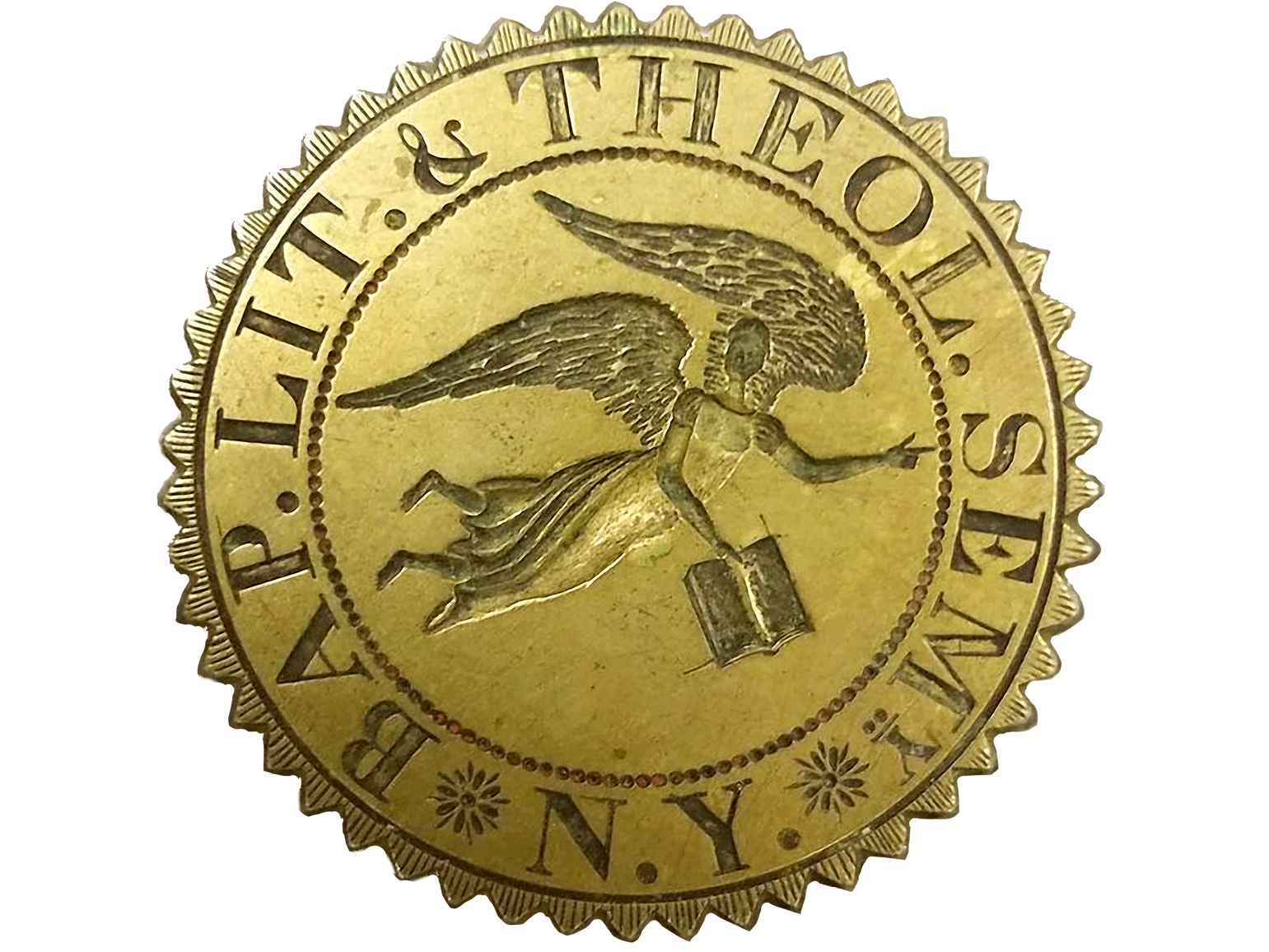

“The story of Colgate’s early years is often confusing because of the variety of names used in referring to it,” the late professor of history and archivist Howard Williams ’30 wrote in his A History of Colgate University 1819–1969.
1819–1833: Baptist Education Society of the State of New York
Daniel Hascall, the Baptist pastor in newly incorporated (1816) Hamilton, N.Y. — inspired by similar efforts in New England, New York City, and Philadelphia — dreamt of creating a seminary in the “West” to prepare young men for the ministry. He and his friend Nathaniel Kendrick recruited other local clergy and laymen to the cause and on September 24, 1817, met in the parlor of Jonathan Olmstead’s home in Hamilton and approved the Constitution of the Baptist Education Society of the State of New York.
Thirteen men — six clergy and seven laymen, including the village’s founding fathers — were present at the meeting. After praying together and then affirming the Constitution — which had 13 articles — the men each paid an annual membership fee of $1 and elected the institution’s first board of trustees. (Olmstead’s home still stands on a hillside south of campus, and Colgate people have considered 13 a lucky number ever since.)
Although Hascall began teaching Latin to the first student (Jonathan Wade) soon after, the institution’s founding date was officially March 5, 1819, the day a bill establishing its incorporation cleared the New York State legislature.
From its founding until 1833, the Baptist Education Society of the State of New York was “loosely referred to” as the “Seminary” or the “Institution.”
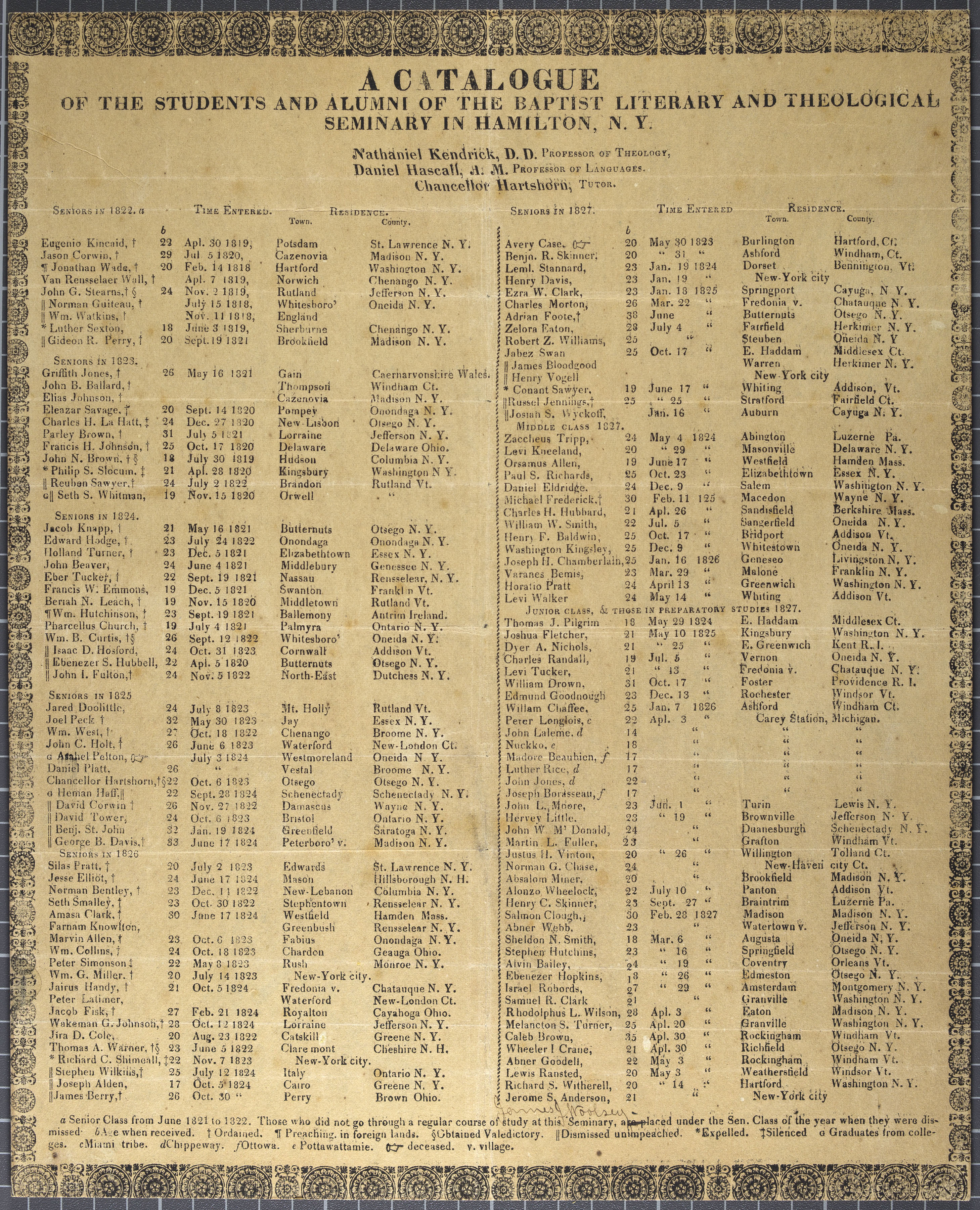
Catalogue of the first students of the Baptist Literary and Theological Seminary, circa 1827

Several central New York communities were proposed as home to the new institution. The trustees chose Hamilton when the people of the village pledged within four years to provide a building valued at $3,500, and another $2,500 to be paid toward board. It proved to be a valuable investment in the village’s future prosperity. Hamilton’s First Baptist Church claims the distinction of “Mother Church to Colgate University.”
1833–1846: Hamilton Literary and Theological Institution
Professor Williams notes that the Seminary was referred to as the Hamilton Literary and Theological Institution from 1833 to 1846. He also records that — except briefly in the early 1820s — the institution was open only to ministerial students until 1839.
Initially, the institution offered a three-year program, which expanded to four years with the addition of preparatory work in 1829. By 1833, responding to student interest, the program included a college course, which was an introduction to the liberal arts. Eventually the faculty adopted a six-year program comprising four years of college work and two years of theological study. A two-year preparatory program was also available, so the institution had evolved to include three departments: the preparatory or academic department, the collegiate department, and the theological department. Enrollment was 124 in 1833, all destined for the ministry.
In a move intended to help secure funding from New York State, representatives of the faculty, board, and some local citizens petitioned the state legislature in 1840 to incorporate the collegiate department as Hamilton University. Adopted by the assembly, the petition was rejected by the senate because it failed to meet financial criteria established by the NYS Regents.
The assembly rejected a second attempt to charter the collegiate department as Madison University in 1843 for lack of what it considered an appropriate governing body.
On recommendation of the faculty (who suggested the name Chenango College), the board filed for incorporation again in 1846 and finally achieved success. In March, the assembly approved a bill establishing Madison University (named for the county where it is located), which was subsequently approved by the senate and signed by the governor.
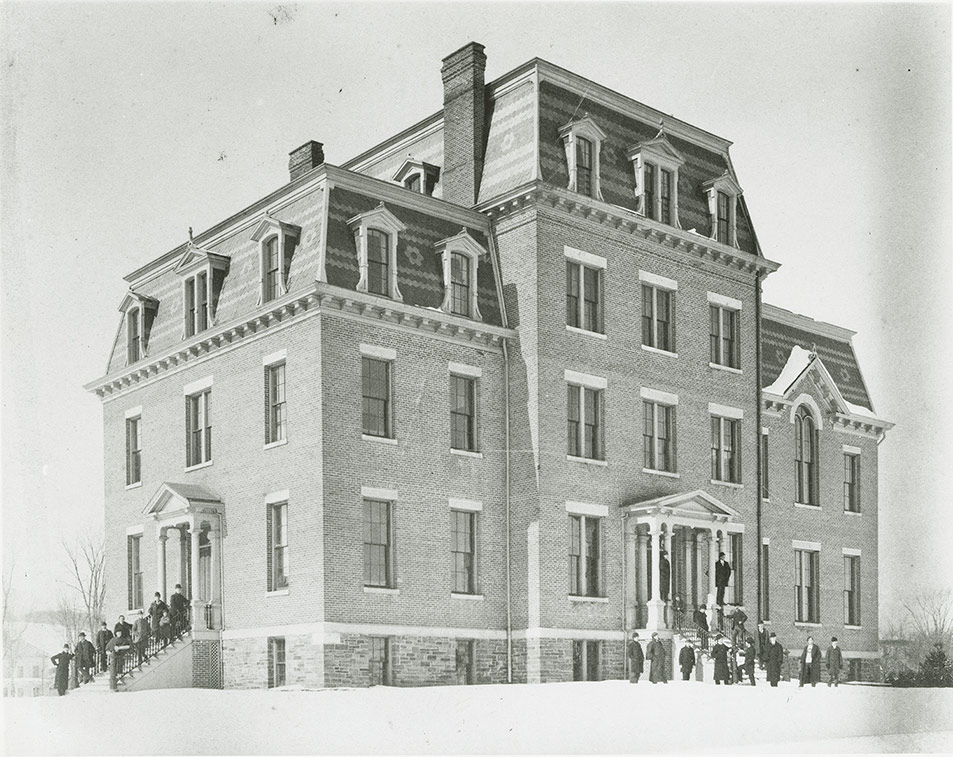
Colgate Academy, 1873

1846–1890: Madison University
When Madison University incorporated in 1846, it had established its own Board of Trustees, separate from the Board of the Education Society, to address the concern expressed by the assembly in 1843. As Williams notes, “The charter defined the purpose of Madison University as ‘promoting literature and science’ but made no mention of training ministers.”
Joint meetings of the boards of the Education Society and Madison University ensured continued attention to theological training in the collegiate division, addressing any immediate concerns. Yet, these early actions can be seen in hindsight to foreshadow future developments such as the Removal Controversy of the late 1840s, and transfer of the Theological Seminary (which had been renamed in 1853) to Rochester in 1928.
Among the many changes that affected the growing university during that period, an increasing secular presence had an impact, especially on student life. The class that entered in 1876 represents the tipping point at which secular students outnumbered those studying for the ministry, certainly a factor in the evolution of the Colgate we know today.
The academic or preparatory department was known as the Grammar School from 1846 through 1873, when the trustees named it Colgate Academy in honor of James B. Colgate’s gift of a new building to house the school. James B.’s gift was made in memory of his parents, William Colgate and his wife Mary, who originated the family’s interest and support in the institution. (Colgate Academy closed in 1912.)
Since 1890: Colgate University
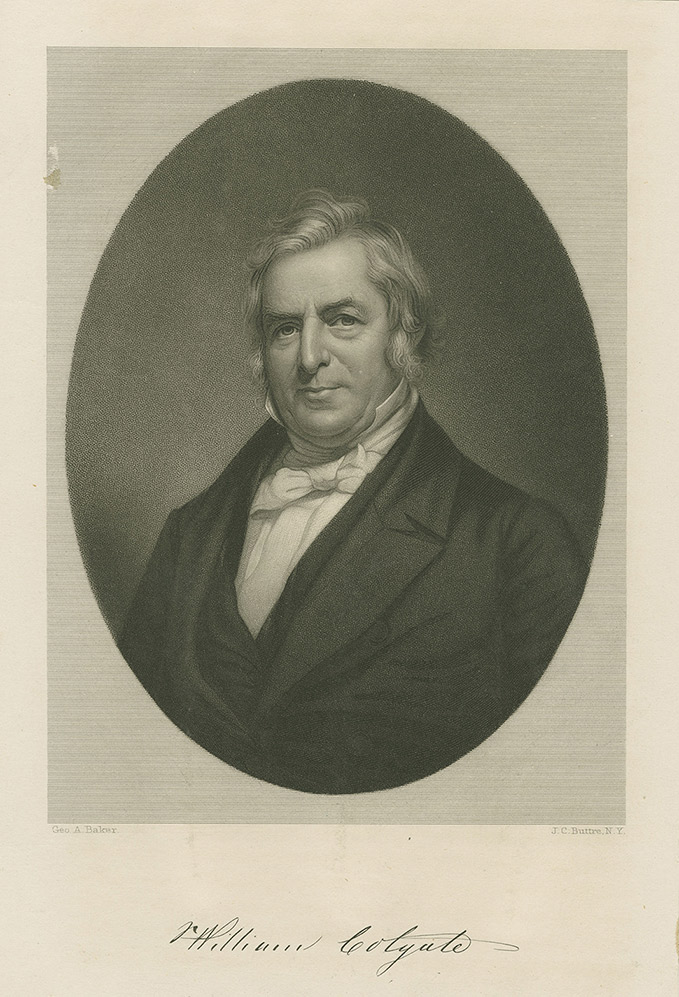
William Colgate, circa 1860s-1880s

Any history of Colgate University — and especially the story of its first century — is interwoven with references to members of the Colgate family and how their steadfast dedication, service, and support has enabled the institution to survive and thrive.
That fact was not lost on trustees, faculty, and students, who early in the 1880s began to suggest renaming Madison University to Colgate. By 1889, the idea had gained sufficient momentum that the trustees voted to petition the New York State Supreme Court to change the name. Eleven months later, on May 26, 1890, following a diligent review by the court, the institution that was founded as the Baptist Education Society of the State of New York became Colgate University.
Williams notes that the Colgate family was not consulted initially about the name change, nor did they favor it, but that they “assented rather than embarrass its advocates.”
Through their financial support, certainly, but also through their leadership, counsel, and active involvement, New York City soapmaker William Colgate and his heirs guided the development of the institution and sustained it when it could not have survived on its own.
From the time he became involved in 1823 until his death in 1857, William was the institution’s preeminent patron. His sons James B. and Samuel stepped up to that responsibility in remarkable fashion.
When James B. died in 1904, he had served 40 years as chair of the University Board of Trustees and given gifts in excess of $1.7 million, including the library (now James B. Colgate Hall), the president’s home (Merrill House), the first $1 million gift to the university (establishing the Dodge Memorial Fund), and personally offsetting annual shortfalls in the operating budget, among many other generosities. He even provided the bathrooms for a renovation of East Hall.
Samuel served on the board of the Education Society for 36 years; the early leaders of the institution relied on his financial guidance. (Samuel Jr., while studying at the Seminary, was the football team’s first coach.)
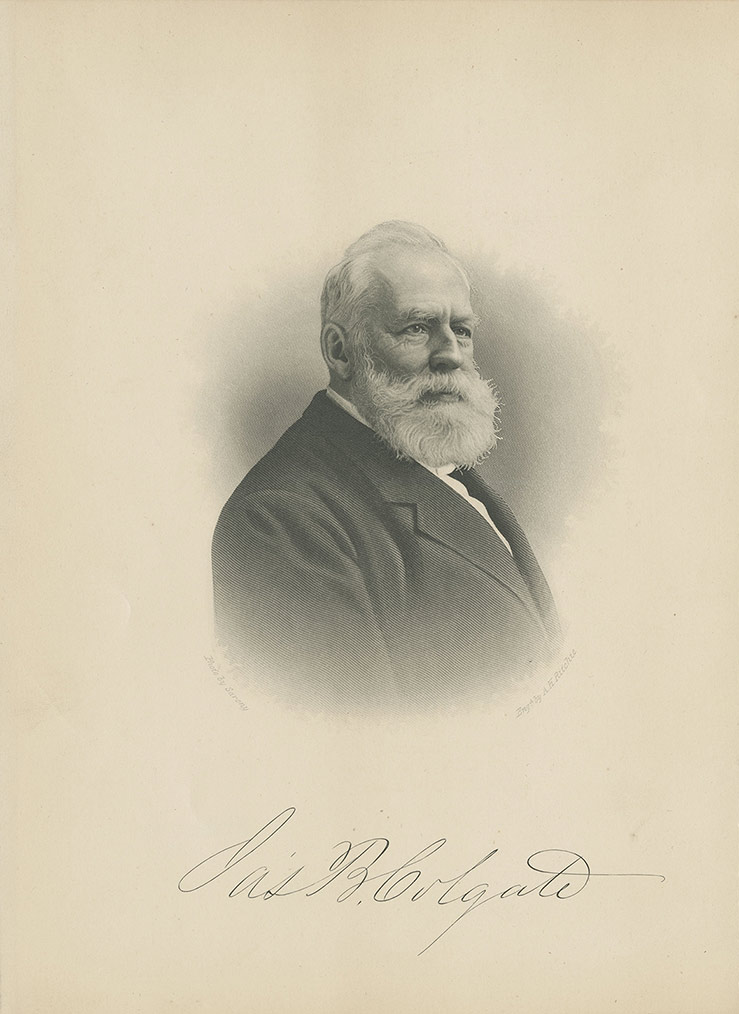
James B. Colgate, 1888

Sidney Colgate, Samuel’s son, chaired the board from 1912 until 1921, when he was succeeded by James B.’s son James C. (Class of 1884), from 1921 through 1935. James C. is credited with contributing more than $300,000 to make up operating deficits between 1899 and 1908. He also gave the swimming pool at Huntington Gymnasium. The student union is named in his memory.
James B.’s daughter Mary gave the chapel, which she dedicated in memory of her father in 1920, and also provided an endowment for its maintenance.
And so the Colgate family’s support has continued to this day, with examples too numerous to report here, other than to say the name Colgate University is well earned and oft reaffirmed.
Notes & Sources
- Williams, Howard D., A History of Colgate University 1819–1969. New York: Van Nostrand Reinhold, 1969
- Memorabilia collection, A1141, Special Collections and University Archives, Colgate University
- Baptist Education Society of the State of New York records, A1010, Special Collections and University Archives, Colgate University
- Buildings and Grounds collection, A1000, Special Collections and University Archives, Colgate University
- Colgate University Drawing, Sketch, and Painting collection, A1212, Special Collections and University Archives, Colgate University
- Colgate University Drawing, Sketch, and Painting collection, A1212, Special Collections and University Archives, Colgate University
